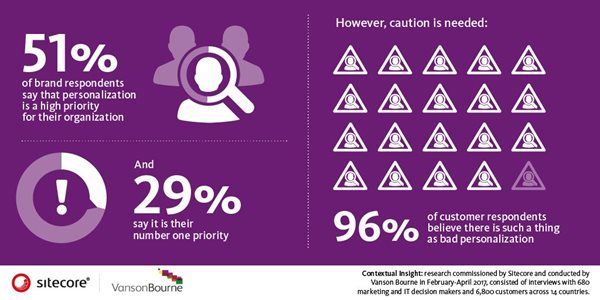Gap Between CEO Expectations and IT Organization Readiness
Personalization, automation, optimization, omnichannel, multi-cloud environments, internet- of-things, voice assistants, artificial intelligence, applications, and all other buzzwords have been thrown into every discussion in the tech industry. Why? Because they are exciting and most of them are game changers. Whether it is a CMO or CTO, all executives are now tasked with thriving in digital transformation through adopting these technology disruptors. However, the need for having a certain level of digital maturity to succeed in Digital Transformation is something that many organizations have overlooked. Therefore, all the technology adoption efforts that are thrown against a wall often don’t stick.
of-things, voice assistants, artificial intelligence, applications, and all other buzzwords have been thrown into every discussion in the tech industry. Why? Because they are exciting and most of them are game changers. Whether it is a CMO or CTO, all executives are now tasked with thriving in digital transformation through adopting these technology disruptors. However, the need for having a certain level of digital maturity to succeed in Digital Transformation is something that many organizations have overlooked. Therefore, all the technology adoption efforts that are thrown against a wall often don’t stick.
In fact, a new study released by Commvault and Quadrant Strategies reveals that while many executives recognize the need to be able to lead their companies through digital transformation, IT personnel actually feel they lack the skillset, technology, and bandwidth to create the data-centric foundation required for that digital change and future innovation. In this article, we will further discuss the relationship between Digital Maturity and Digital Transformation in light of the findings from the study.
Is Your IT Team Ready for Digital Transformation?
Digital transformation involves different thinking, innovation, a modification in leadership & new business models and incorporating digital strategy into all aspects of the business to improve the experience of your organization’s employees, customers, suppliers, and partners. To build those new, innovative company cultures, business models, and digital strategies, organizations need a solid IT infrastructure that supports all the upcoming changes in agility, innovativeness, and security.
To measure IT’s readiness for digital business, in the scope of the study aforementioned, 1,200 IT executives and IT personnel in six global business markets have been surveyed. While 41 percent of executives believe their organizations understand and are prepared for innovation (already a surprisingly low number), only 29 percent of IT personnel believe the same. Further, over a third of IT personnel think executives would feel concerned, anxious or panicked if they knew more about their IT department, while another 16 percent said they’d be unhappy, angry or disgusted.
No wonder why some table stake technologies like mobile-responsiveness or marketing capabilities like personalization haven’t taken off from the ground yet. Still, the majority of brands are making assumptions about what customers want based on single interactions. You may think, by this point in time we have gone past that but it is in the data from a recent research commissioned by Sitecore and conducted by Vanson Bourne. This particular study surveyed 680 marketing and IT decision makers as well as 6800 consumers and unveiled that 96% of 6800 customer respondents believe many brands are in fact, providing “bad personalization”, which upon deeper analysis, is no personalization at all. When I interviewed two Sitecore executives on this finding, both leaders indicated that the main reason is trying to ride the waves too quickly without reaching a certain level of digital maturity. In other words, technology adoption failures, just like bad personalization here, are the results of an alarming gap between the expectations of management and the readiness of IT organizations.

As a great example of that gap, the study conducted by Commvault and Quadrant Strategies discloses that most IT executives prioritize day-to-day operations over innovation, and IT personnel follow their lead. According to the findings, IT organizations agree on the importance of data management in order to innovate and accomplish the remarkable things required for creating a digital business and improving customer experience. However, the same study reveals that more than 75% of respondents believe their organizations are not prepared for migrating data to the cloud, protecting that data, or bringing together all data in the company. Far worse, more than 60% of respondents, including IT executives and IT personnel, think they have access to less than half of their organizations’ data.
The creation of new business models by integrating ecosystems of people, business, and things is the bread and butter of succeeding in innovation and becoming leading-edge companies. Good news, more than 50% of participants agree on this point, saying that better data collection and management, along with new tools to analyze that data, are vital for the future of their businesses. However, with the lack of access to data and without setting up a clear alignment on the goals, execution, deployment, and strategy across the entire organization, a claim on success in Digital Transformation remains, unfortunately, vague. Conversely, the common drive among progressive CEOs and CIOs, who have transformed the business models to future-proof their organizations and reshape their industries, is that they believe in creating a data-centric foundation that not only supports more cost-effective current operations but also provides deeper business insights and the agility to support radical new ideas and new applications for doing business with customers.
Not only is a gap between the expectations of management and the readiness of IT organizations alarming but also a talent gap, not least in emerging technology fields such as data scientists or user-experience designers, is an alarming threat for many organizations as the situation may throw a wrench in the works. If we circle back to the study, again, more than 50% of IT personnel believe their roles will change radically and they will need to acquire new skills to stay relevant. Afshin Mohamadi, Partner at Quadrant Strategies encapsulated the study with an on-point statement: “The warning signs are very clear: while IT departments are meant to spearhead digital business, they aren't equipped to do so. IT personnel have significant doubts about their abilities to be the agents of change. The lack of skillset, technology, and bandwidth will lead directly to major competitive challenges.”
My POV: Ready, Set, Go!
Unfortunately, there is no silver bullet to Digital Transformation because it is not a sprint, rather, it is a marathon without a finish line. Just because you are armed enough to jump over one obstacle, doesn’t mean you are ready to run the whole marathon. You need to examine the end-to-end journey and map it out holistically without leaving any gaps.
That being said, I do not suggest leadership take their time while we are living in the world where things are moving on at light speed and time has become a currency. Conversely, what I suggest is finding the fine pace somewhere between their industry and their organization. Because of all these time and resource pressures, one of the most common mistakes that organizations make is following the leaders in the markets they serve regardless of their IT’s readiness. It may seem a fast and proven method at first glance but it is just quick and dirty way to get things done and the price, typically, is much more costly than developing a holistic digital strategy that is right for them.
It’s important to fully understand where your organization has been, where it is now and where you're heading for a total 360-degree view of your digital transformation.

Venus Tamturk
Venus is the Media Reporter for CMS-Connected, with one of her tasks to write thorough articles by creating the most up-to-date and engaging content using B2B digital marketing. She enjoys increasing brand equity and conversion through the strategic use of social media channels and integrated media marketing plans.